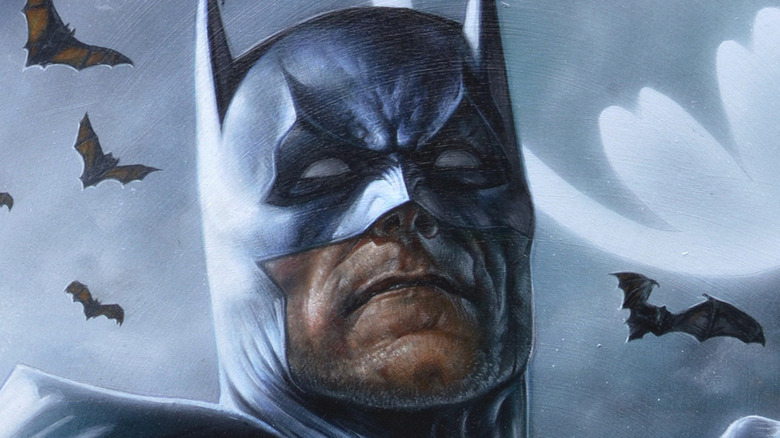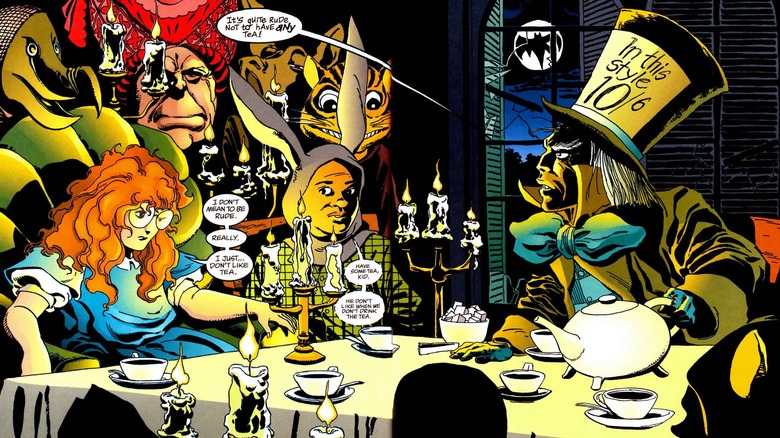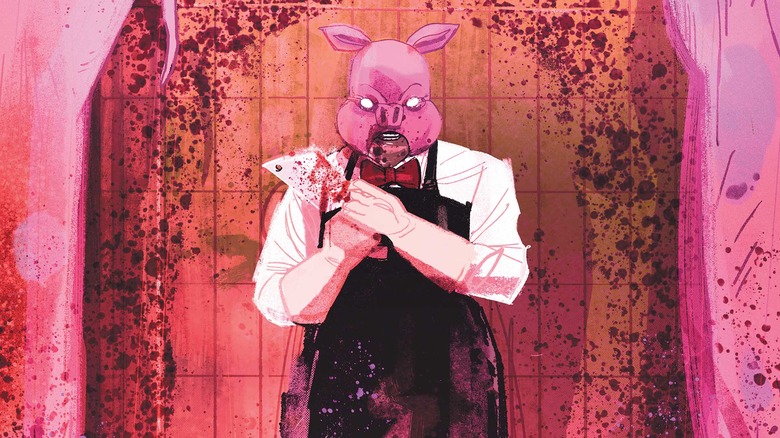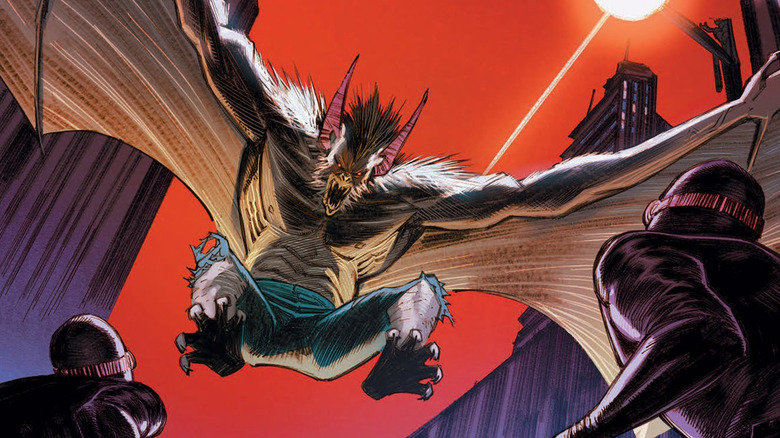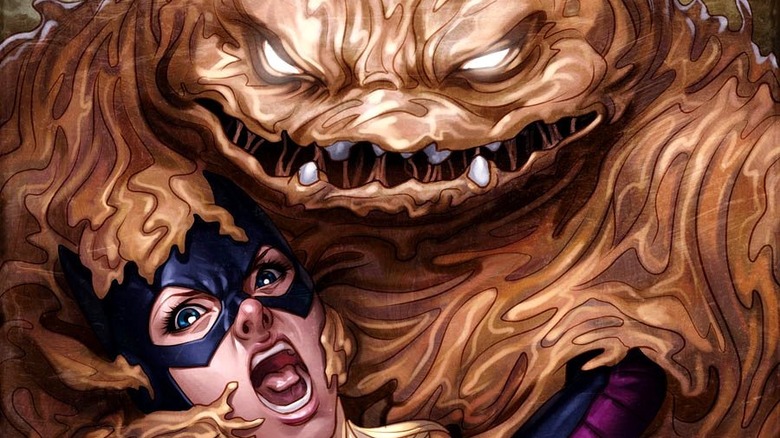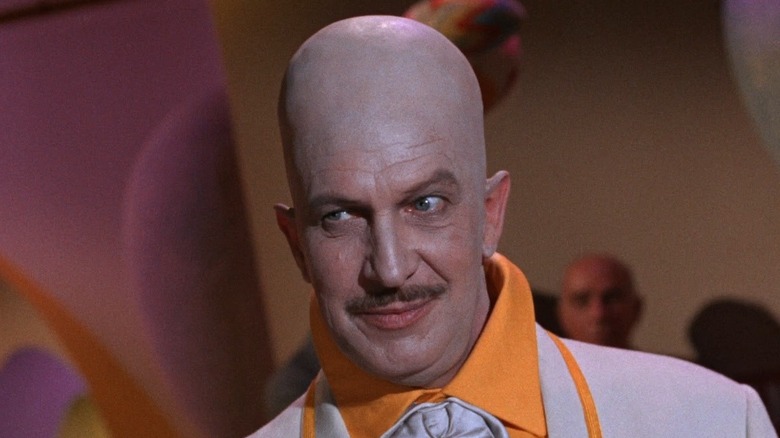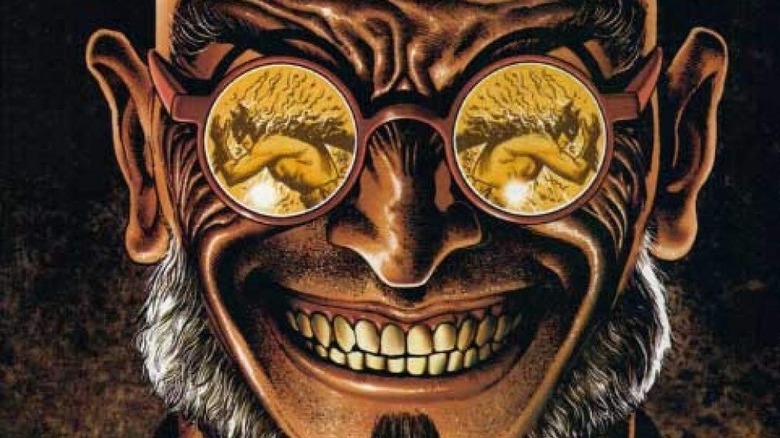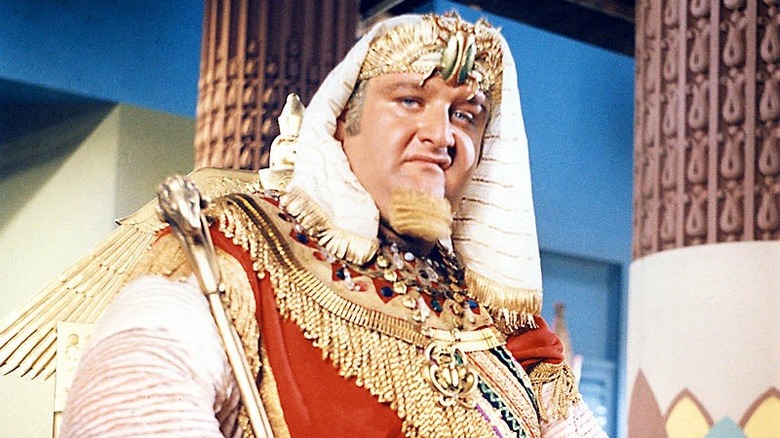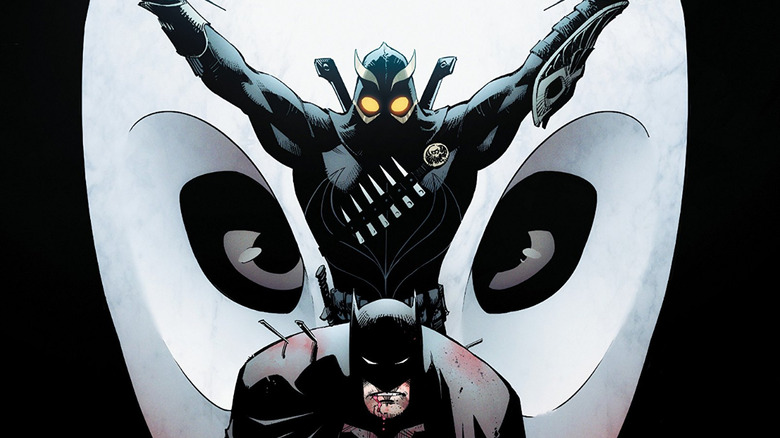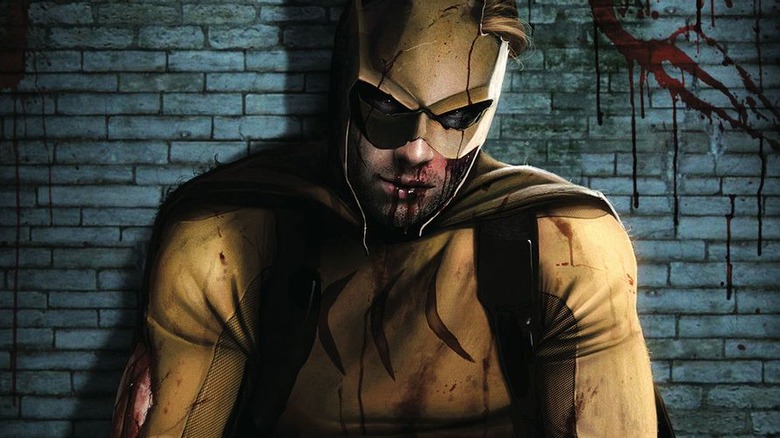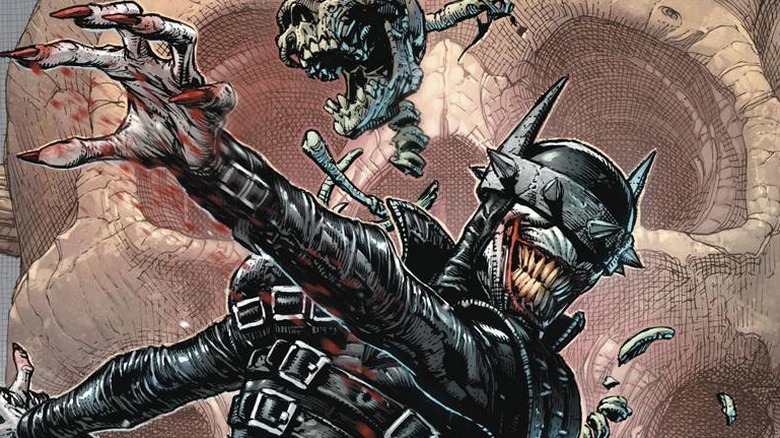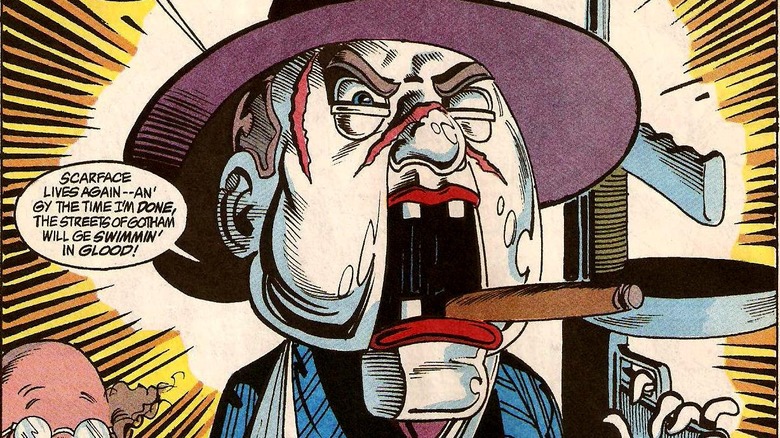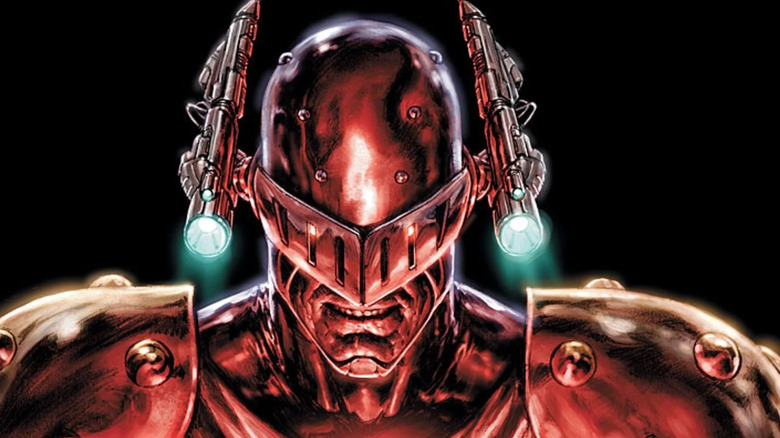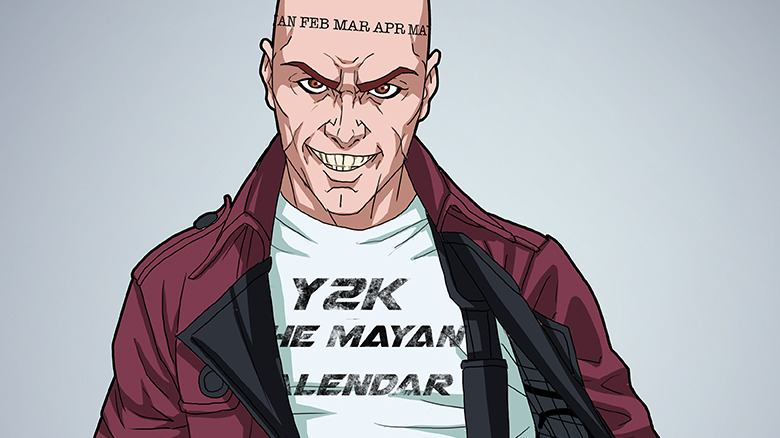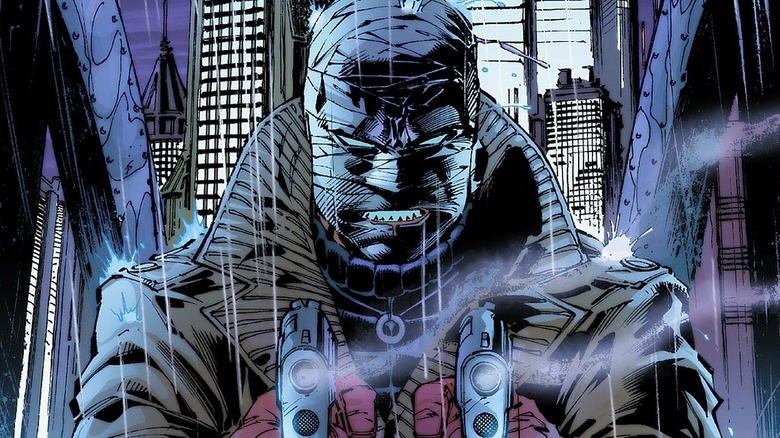The Best And Worst Batman Villains We Haven't Seen On The Big Screen Yet
Few heroes have as diverse, colorful, and menacing a group of villains as the Caped Crusader himself, Batman. With such a long publishing history, he's seen everything from standard crime bosses to comically costumed villains like Joker and the Riddler, as well as nemeses that are something other than human — Clayface, Killer Croc, and others. He's one of the smartest, most adaptable heroes in the DC Universe, so it takes a lot to challenge his dominance for the streets of Gotham.
While we've certainly seen some of his greatest villains on the big screen — multiple Joker iterations, Two-Face, Bane, the Riddler, Catwoman, and others — there are many we have yet to see. What's more, with so long a history and so wide a range of foes, some of the villains we have yet to see are amazing (well-developed, a true threat) while others are ... not so much. A couple of great characters like Red Hood and Azrael even fill a more anti-heroic role, sometimes fighting Batman, sometimes fighting on his side. Those characters aside, here are the best and worst Batman villains we have yet to see on the big screen (minus perhaps a couple of brief cameos in "The Lego Batman Movie").
Worst: Mad Hatter is a one (weird) note villain
Mad Hatter, the villainous moniker of Jervis Tetch, first appeared in "Batman" #49 and is, as the name suggests, an "Alice in Wonderland"-themed villain. Tetch is a Lewis Carroll-obsessed but brilliant neuroscientist who came to believe he is the incarnation of Carroll's 'Mad Hatter' character. Like many Batman villains, he's criminally insane and most of his crimes have an "Alice in Wonderland"-flavored element (even throwing the occasional tea party).
At the same time, Tetch is not without skill. He's a master of hypnosis and mind control, and is widely known for the development of a wide array of hats with embedded technology that allows him to control the will of his victims. Over time the character has been written a little less comically and with a little more menace, going so far as to kidnap children and dress them up as Wonderland characters (as happened once to a young Barbara Gordon). The character's criminal insanity and mind control abilities aside, a character obsessed with "Alice in Wonderland" is a little too odd relative to many other Bat-baddies.
Best: Professor Pyg is odd but frightening
Another odd villain with a unique and unsettling visage, Professor Pyg debuted in the non-canon future in "Batman" #666. He was originally portrayed as a Gotham crime boss, and instead of his iconic mask the character had pig-like features; in that non-canon story he ends up dead. The character later reemerged in canonical DC properties, with the Professor Pyg moniker referencing both the myth and the play "Pygmalion." In the myth, Pygmalion is a sculptor who fell in love with his statue creation. In the play, Professor Henry Higgins attempts to change the speech of a Cockney flower seller to make her "pass" in high society.
Professor Pyg is a twisted amalgamation of the two; he's obsessed with changing people to make them "perfect," using chemicals and torture to transform people into "Dollotrons," identical living dolls who are brainwashed into obeying his every whim — effectively human robots. It's a horrendous form of mind control for a heinous villain, and while he's an eccentric mind controller like the Mad Hatter, his methods and aesthetic are less whimsically odd and more nightmarish and disturbing. Believe me, you do not want to be under his knife.
Worst: Man-Bat is a shallow inhuman oddity
If "Batman" is a man (Bruce Wayne) who dresses like a bat, on paper it makes sense to have a villain who is an actual bat-man hybrid. Enter Dr. Kurt Langstrom, a Batman villain who first appeared in "Detective Comics" #400. Langstrom specialized in studying bats and developed an extract designed to give humans the same sonar sense that's a distinct trait of said flying rodents. Naturally he tested the experimental drug on himself ... and, of course, it had a small side effect: it gradually transformed Langstrom into a humanoid bat-monster. Man-Bat first became an enemy to Batman when the former attempted to steal chemicals to transform himself back into a man.
Langstrom refined his serum to better control his transformations and retain his human intelligence while transformed. For a time he became a "crime fighter" while in his bat-like form, before the bat-side of his transformed state progressively attained dominance over his overall being. While in his monstrous form he has enhanced attributes, the ability to fly, and sharpened claws, and he surely provides a challenge to Batman in their repeated encounters. At the same time, it's a fairly one-note villain who clearly exists only to conceptually play on the bat/man dualism. As fun as it is to watch the Dark Knight take on a humanoid creature, this is one flying beast that simply doesn't land.
Best: Clayface is a powerful challenge to the Dark Knight
The original Clayface (premiering in "Detective Comics" #40) was the actor Basil Karlo, who felt betrayed when he discovered he wasn't cast in a remake of one of his classic horror films. He adopted the persona of a villain from one of his films, Clayface, and sought to kill the cast and crew before defeat at the hands of Batman. Karlo later allied with similarly clay-themed villains, Lady Clay, Clayface II (Matthew Hagan), and Clayface III (Preston Payne), tricking them to absorb their actual powers as beings made of a malleable clay-like substance The new bodily structure allows him to alter his size, shape, and density, even to impersonate the visage of any living person or regenerate damage.
Clayface is a visually intriguing villain with a unique set of powers, ones that challenge Batman both physically and mentally. How do you stop such an adaptable villain? One that can appear as anyone or anything and that can regenerate and form weapons from his body? His horror movie origins, menacing abilities, and adaptability have made him a popular character time and again, and the Matt Hagen version of Clayface was a popular nemesis in "Batman: The Animated Series."
Worst: Egghead is simply too cheesy to be menacing
Egghead (aka Edgar Heed) was one of a number of villains created for the 1960s "Batman" TV series. The character was portrayed by the iconic Vincent Price and thought himself to be the world's smartest criminal. Sporting a bald head, white and yellow suit, and a variety of egg puns, the majority of Egghead's crimes had, you guessed it, some sort of egg motif to them. He also invented a number of egg-based or egg-like weapons, like eggs containing various gasses. Egghead was a recurring villain in the series, and he carried over later into "Batman: The Brave and the Bold" as well as a brief cameo in "The Lego Batman Movie" (yes, that's technically a big screen debut, but he's never received the dedicated live-action feature film treatment).
As a character, Egghead was one of only two villains in the TV series to deduce Batman's true identity as Bruce Wayne (the other being King Tut). Many of Batman's villains are somewhat over-the-top, but an egg-themed villain is absolutely too much. Not even the incredible Vincent Price can make an endless array of egg puns work, and his criminal compatriots have names like Benedict, Foo Yung, and Miss Bacon. He's simply too goofy to feel like a true threat.
Best: Hugo Strange is an obsessive, dangerous criminal mastermind
Professor Hugo Strange (premiering in "Detective Comics" #36) debuted as a criminal psychologist with a brilliant mind and a knack for engineering criminal schemes. Engaging in a variety of malevolent plots and encounters with Batman over the years, Strange became increasingly obsessed with the Caped Crusader and eventually discovered Batman's true identity as Bruce Wayne, one of a small number of villains to do so. Perhaps Strange's biggest weakness is his fractured mind, suffering episodes of mental instability that regularly impede his ability to use his knowledge of who Batman really is.
This complicating limitation notwithstanding, Strange has a stunning number of other criminal accomplishments under his belt. He's framed Batman as a criminal, led gangs of super-criminals, attempted to kill and replace Batman on more than one occasion, and has even conducted experiments that turn ordinary people into monstrous, hulking cannibals called "Monster Men," which he controls. His incredible intellect and obsessive madness make Strange one of Batman's greatest and most dangerous foes. For this reason, he's been a regular menace in shows like "Batman: The Animated Series" and "Gotham," but other than a brief cameo in "The Lego Batman Movie," he's never made the jump to the big screen.
Worst: King Tut is another TV villain that's just too silly
King Tut, the alias of William Omaha McElroy, is another Batman villain that originated with the 1960s Batman TV series (as well as being one of two TV-based villains who solved Batman's true identity as Bruce Wayne, alongside Egghead). The villain began as a humble Egyptologist at Yale, who got caught in a violent student protest that involved rock throwing. One of the rocks knocked the professor unconscious, and he emerged believing himself a reincarnation of King Tutankhamun (and that Gotham is the ancient city of Thebes). His goal? To regain control over Goth... um, Thebes. And of course, Batman stands in his way.
Everything Tut uses has an ancient Egyptian theme, and he even spouts Egyptian curses at his foes. He also has a host of underlings, all with Egyptian-themed motifs like Nefertiti, Cleo Patrick, and others. While he's a visually archaic villain, the foe actually had some interesting weaponry, including a hollow Sphinx statue that made "predictions" and a potion called "Abu Rabu Simbu Tu" that could paralyze human will. So far his only big screen appearance is, you've guessed it, as a cameo in "The Lego Batman Movie." It's another case of a villain that's just too conceptually and visually silly to seem truly menacing.
Best: the Court of Owls threatens the Waynes' legacy of good
As intimately as the Wayne family is tied to Gotham history, the mysterious Court of Owls organization has an even deeper, more menacing Gotham legacy. The organization is an old criminal cabal with ties to the foundations of Gotham, premiering in "Batman" #1 of the "New 52" era (2011). They're a wealthy secret society that strives to manipulate Gotham's future, and they've been around so long that they have hidden rooms throughout Gotham's most notable buildings.
Beyond their secrecy and massive wealth and power, the Court of Owls' most notable attribute is their cadre of assassins called Talons, who are deadly, highly skilled combatants. What's worse is that the Court of Owls has a way of preserving Talons potentially for centuries, placing them in suspended animation to be reactivated when the Court needs someone dead. Even one Talon proved a challenge for Batman, and the Court nearly broke him in a massive labyrinth. The most menacing part of the Court? Their very existence has always challenged the Waynes' ability to do good in the city, and they flew right under Batman's own rhetorical nose as a mysterious threat that can always rear its ugly head once again.
Worst: Catman, the cheap Batman knockoff that no one wants
Catman is the alias of Thomas Blake, a well known trapper of jungle cats who debuted in "Detective Comics" #311. Having squandered his family fortune, Blake turned to a life of crime and adopted the Catman persona at a time when Catwoman had retired from criminal activity. Much like Catwoman, he's a cat-themed burglar who has frequent run-ins with Batman. Unlike Catwoman ... he's historically not very good. Often a joke among other super-villains, Catman spent years losing repeatedly to Batman and Catwoman before retiring. Catman was so bad that he regularly survived deadly accidents only because part of his costume was magic and granted him nine lives. He moved to Africa to live among lions before he eventually made his way back into crime as a member of the Secret Six.
The recent "Villains United" storyline has seen a resurgence in the character and a slight ramping up of his threat level, but at the end Catman is both a pretty sub-par villain and reads as a hybridized knock-off of both Batman and Catwoman, failing to be as good as either. Literally all his weapons except for his magical suit are direct Batman copies as well — he has a Catsuit, a Catmobile, and on Earth One he sported Catarangs. At the end of the day, instead of feeling the menace of Joker, the power of Bane, or the intellect of the Riddler, Catman makes you feel ... just sad, because he tries so hard and fails as hard as he tries.
Best: Batman Who Laughs has built a solid DC legacy
The "Batman Who Laughs" is a newer villain but his impact on the DC Universe is massive. Debuting in "Dark Days: The Casting" #1, he's the Bruce Wayne of Earth-22, a version of Batman who was subjected to an incurable version of the Joker toxin. The toxin made him become an effective hybrid of Batman and the Joker — the intelligence, fighting prowess, and technology of Batman combined with Joker's chaotic evil and unpredictability. He's adorned with a visor that allows him to exist outside the Dark Multiverse and which hones his ability to "see" the Dark Multiverse, and often accompanied by a group of feral, Jokerized children called Robins.
Originally a lieutenant of Barbatos (the being created by the World Forger to destroy failed universe creations), the Batman Who Laughs is a perfect example of someone who is always striving: from Barbatos, he was chosen to be the agent of the cosmic entity Perpetua (the first creator of the Multiverse). Then he acquired Doctor Manhattan's powers, becoming a nigh-omnipotent threat to the entire multiverse. He's an overall great and frightening villain who has done everything from commanding an army of dark, super-powered Batmen to corrupting the world's greatest heroes to fighting cosmic-level entities. He's also an interesting example of what happens when you have too much of a good thing, moving from a good character with an intriguing story arc to becoming the center of much of the DC universe and a cosmic-level threat quite suddenly. Nonetheless, he's an intriguing villain in the new era of DC.
Worst: Ventriloquist/Scarface is more strange than menacing
The Ventriloquist, aka Arnold Wesker, premiered in "Detective Comics" #583 and began life as an orphan whose deeply repressed nature lead him to one day lash out in a barroom altercation. He was sent to Blackgate Prison, where he acquired the dummy Scarface — a dummy dressed as a 1920s gangster, with whom he became inseparable. Under the dummy's influence, Wesker is a ruthless criminal overlord, and while he sees himself as being forced to do the dummy's evil will, the overall consensus is that he suffers from multiple personalities and "Scarface" is his deadly, dark self.
There have been a number of great TV episodes and horror movies involving ventriloquist dummies: Hugo, the dummy from the horror anthology "Dead of Night" (1945), Fats from "Magic" (1978), the two creepy dummies from two different "Twilight Zone" episodes ("The Dummy" and "Caesar and Me") ... you get the idea. But it's another villain concept that doesn't measure up to the various Batman baddies, often reading as more comical and less menacing.
Best: Prometheus, a top-tier anti-Batman
The unnamed villain known only as Prometheus who first debuted in "New Year's Evil: Prometheus" #1 is, like a number of Batman's greatest villains, a dark reflection of the Caped Crusader. Born to a pair of criminals, the young villain watched his own parents get gunned down by police officers in front of him, setting him on a lifelong pursuit of destroying the law. A true anti-Batman, his intellect and combat prowess rival Batman's own, with top-tier skill as a marksman and martial artist. His attributes are also enhanced by an armored suit that makes him resistant to damage while his helmet, connected to his nervous system, enhances his tactical analysis and enables him to download any information of fighting styles directly into his system.
Prometheus is a mysterious and dangerous adversary (one with a home in the Phantom Zone, no less), and like Batman he's one that is a threat to the entire Justice League, dedicated to the sole pursuit of destroying law and order for its own sake. He's truly one of Batman's greatest foes, and whenever he pops up next he's sure to cause significant damage to the superhero community.
Worst: Calendar Man isn't even the star of his best story
Calendar Man debuted in "Detective Comics" #259 with the modus operandi of committing crimes that correspond to various holidays and specific dates on the calendar. (Even his name, Julian Gregory Day, is a multi-layered calendar pun, with the Julian and Gregorian calendars being historically significant Western calendar systems). Each crime has a specific connection to its day on the calendar, and it seems that Day's greatest joy is to challenge and defeat Batman.
Calendar Man is not necessarily a bad villain from a conceptual standpoint, certainly no worse than so many other hyper-specific opponents of the costumed vigilante. The reason he ultimately gets put on the "worst" list is because of the irony that perhaps his best known recent story is "The Long Halloween," where Gotham is plagued by a calendar-based serial killer called Holiday. Calendar Man is called in to consult on the crimes in Hannibal Lecter-like fashion. Calendar Man belongs on the worst villains list because his most notable story is a great one about a spree of stunning calendar-themed crimes that aren't even his. When his most notable story moment is a copycat stealing his M.O. in what would be his best story, it goes to show the limitations of one Julian Gregory Day.
Best: Hush is a top-form villain with a personal backstory
Hush is the villainous moniker of Dr. Thomas "Tommy" Eliot, a childhood friend of Bruce Wayne who was, nonetheless, a sociopath. Unbeknownst to Bruce, Tommy (debuting in "Batman" #609) had tried to kill his own father to inherit his family's wealth, a plot spoiled by Bruce's father's skill as a surgeon. Tommy blamed Bruce. Later, Eliot became a surgeon himself, then disguised himself as a criminal called Hush with a bandaged face and an elaborate plan involving a number of Gotham's super-villains. Physically strong and a master physician, strategist, and marksman, he also holds two advantages over Batman: he was Bruce's childhood friend, and he has unbridled hatred for him.
Hush is altogether one of Batman's greatest villains. He's among his smartest enemies as well, able to engineer complex, multi-level schemes that can certainly put Batman on the back foot, while knowing the hero's psychology intimately. Moreover, that one-sided childhood friendship is a deep and complicated connection, one that gives him tactical advantages that are quite personal. Hush is an antagonist that came from nowhere as far as Bruce was concerned, and that rarely happens ... but he turns out to be one of his most personal, and memorable, villains.
